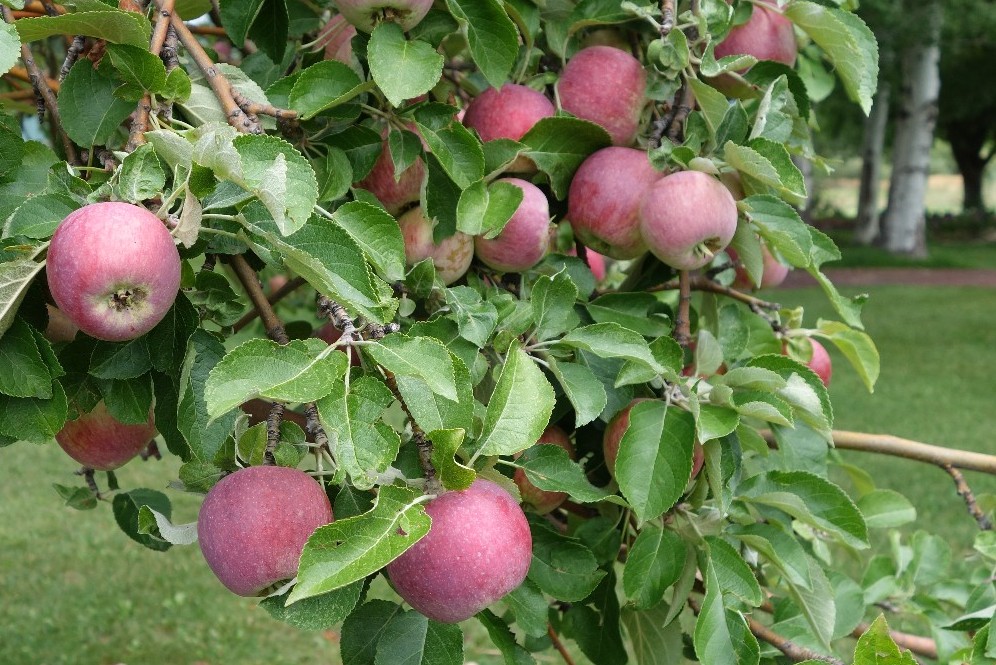Now is the time to prune your trees and shrubs and pruning your fruit trees should be on the top of your gardening “to do” list. The best time to prune fruit trees is late winter or early spring before the blossoms open, so depending on where you live in our area, now is the time in most places.
A fruit tree that has reached its mature size and is yielding fruit requires regular pruning. You prune trees for several reasons. Most home orchard fruit trees are spurring types which means that they grow short branches (3-5″) where the trees then flower and set fruit. Pruning removes competing suckers or branches, removes dead or diseased wood, and controls the strength of the tree by giving it a nice shape. The main goal is to establish four or five strong scaffold branches which will form the framework of the tree.
Choose these main scaffold branches carefully. The ideal branch will extend from the tree trunk at a 45 degree angle and each branch should point in a different direction. There should be intervals of at least 8 inches between these scaffold branches. Pruning the central leader of the tree is not recommended, however, if it is broken or damaged, you may want to do that, realizing that your tree may not end up as nicely shaped.
Keep in mind that for the first few years you are simply wanting to take suckers, water sprouts, small twigs, and cross branches out to allow light to reach the interior of the tree and allow fruit to develop and ripen.
Begin by pruning any dead or diseased wood. These branches will be the easiest to spot by late winter because they will appear shriveled and the buds will be dry as compared to live wood that will show healthy, swelling buds. The branches may be a different color than the others or part of the bark may be falling off. If that is the case, you definitely want to remove that because the open wound is an invitation to insects or disease that will cause further damage.
Move on then to the suckers. These are the branches growing from the base of the tree. They serve no purpose and removing them will greatly enhance the overall shape and appearance of your orchard. Water sprouts are thin branches that usually grow straight upright and rarely bear any fruit so removing them as well, will direct the trees energy to actively producing branches. Small twigs, under ½” in diameter which are growing toward the inside of the tree or from the underside of the limbs should also be removed.
Since apple trees bear most of their fruit on long-lived spurs – fat, stubby growth that grows less than an inch a year, it’s beneficial to occasionally thin these out as well, particularly if they are overcrowded, old, or weak. This allows the remaining spurs to be more evenly distributed through the structure of the tree.
Eliminate any low branches up to approximately 4′ off of the ground. They are an invitation for animals to graze and usually don’t produce fruit well.
If you have a tree that has cross branches- branches that are rubbing against each other, save the best of the two and prune the other one out. If you don’t remove them now, as they grow, they will get thicker and heavier and one will eventually damage the other by rubbing the bark.
Then focus on thinning branches that are on the interior. Remove spindly growth and be as ruthless as possible. When you are finished, your fruit trees should have a pyramidal shape with well spaced branches and a nice look. Remember that all of these limbs that you are pruning simply sap energy from the tree. Removing them will redirect energy to the actively growing wood and help to keep the tree producing well.
Make your cuts with sharp pruning shears, loppers or a pruning saw and be sure they are sharp and sterilized, especially if your are working on a tree that is susceptible to fire blight. Cut as close as possible to the origin of the branch and never leave stubs that will eventually die and may spread decay into the remaining live wood.
Although many people shudder at the thought of pruning any trees, much less fruit trees that you may be depending on for food later in the season, it’s really not that difficult once you take some time to learn to do it well. Ultimately the goal is a happier, healthier, more productive tree.

